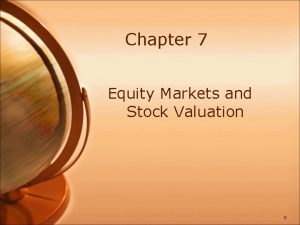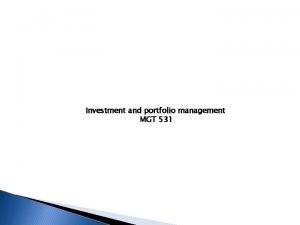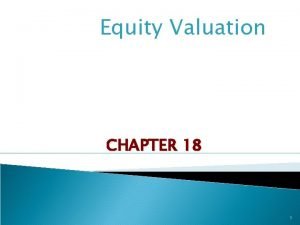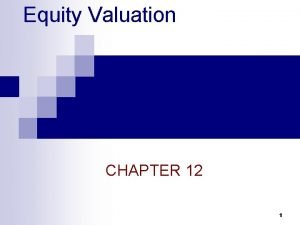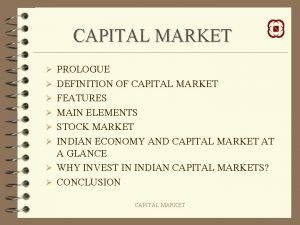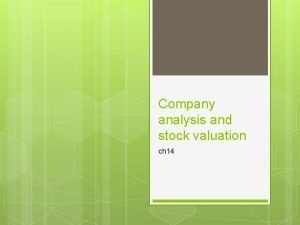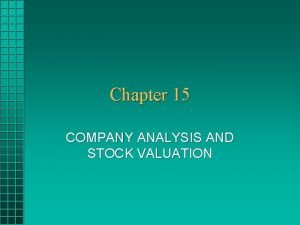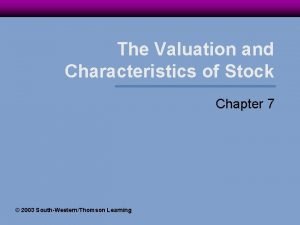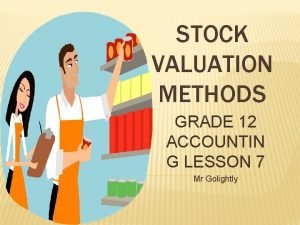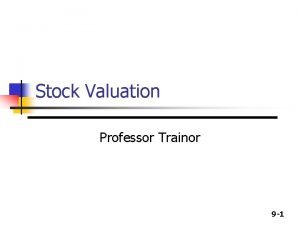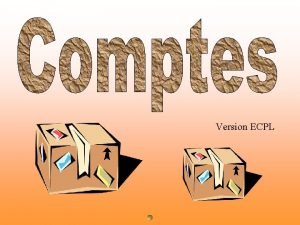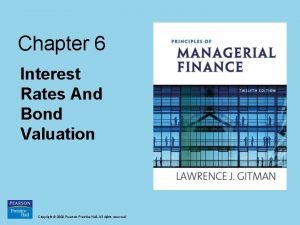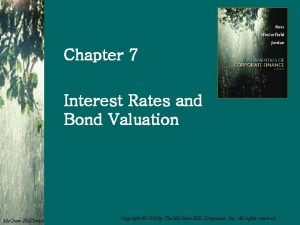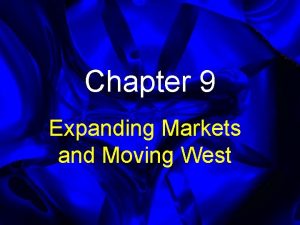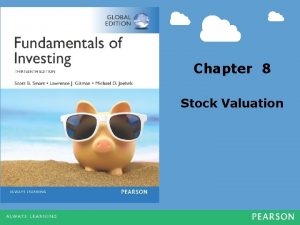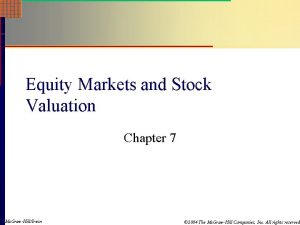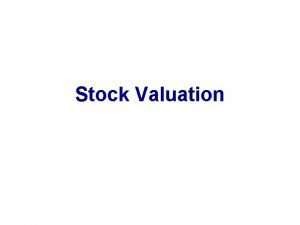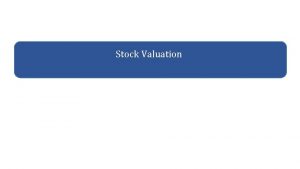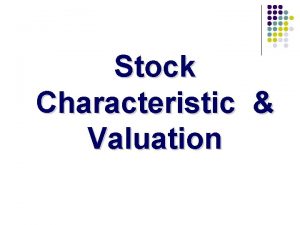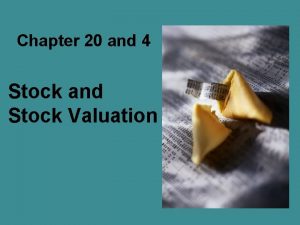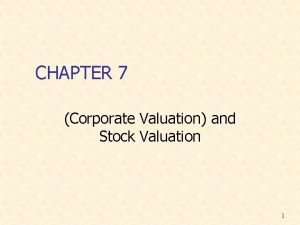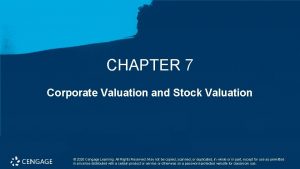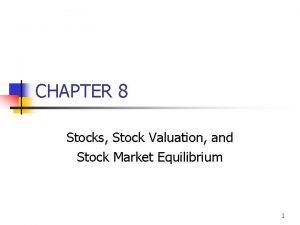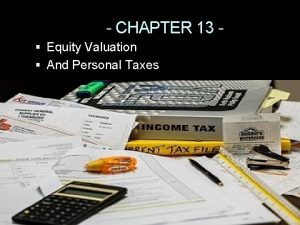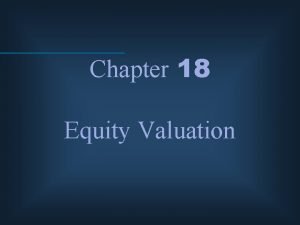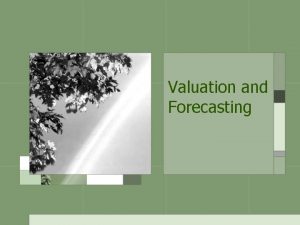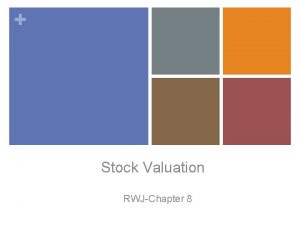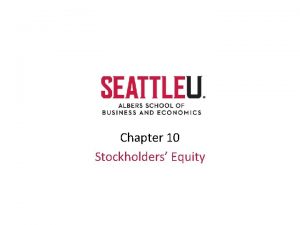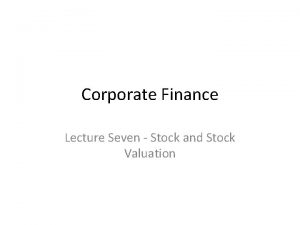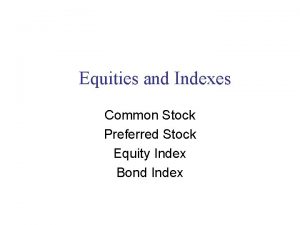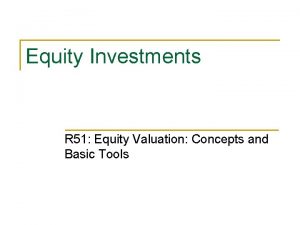Chapter 7 Equity Markets and Stock Valuation 0


























- Slides: 26

Chapter 7 Equity Markets and Stock Valuation 0

Cash Flows to Stockholders • If you buy a share of stock, you can receive cash in two ways • The company pays dividends • You sell your shares either to another investor in the market or back to the company • As with bonds, the price of the stock is the present value of these expected cash flows 1

One-Period Example • Suppose you purchase the stock of Moor Pork. You expect it to pay a $2 dividend in one year, and you believe that you can sell the stock for $14 at that time. If you require a return of 20% on investments of this risk, what is the maximum you would be willing to pay? • Compute the PV of the expected cash flows • Price = (14 + 2) / (1. 2) = $13. 33 • Or FV = 16; I/Y = 20; N = 1; CPT PV = -13. 33 2

Two-Period Example • Now, what if you decide to hold the stock for two years? In addition to the $2 dividend in one year, you expect a dividend of $2. 10 and a stock price of $14. 70 both at the end of year 2. Now how much would you be willing to pay? § PV = 2 / (1. 2) + (2. 10 + 14. 70) / (1. 2)2 = 13. 33 § Or CF 0 = 0; C 01 = 2; F 01 = 1; C 02 = 16. 80; F 02 = 1; NPV; I = 20; CPT NPV = 13. 33 3

Three-Period Example • Finally, what if you decide to hold the stock for three periods? In addition to the dividends at the end of years 1 and 2, you expect to receive a dividend of $2. 205 and a stock price of $15. 435 both at the end of year 3. Now how much would you be willing to pay? § PV = 2 / 1. 2 + 2. 10 / (1. 2)2 + (2. 205 + 15. 435) / (1. 2)3 = 13. 33 § Or CF 0 = 0; C 01 = 2; F 01 = 1; C 02 = 2. 10; F 02 = 1; C 03 = 17. 64; F 03 = 1; NPV; I = 20; CPT NPV = 13. 33 4

Developing The Model • You could continue to push back when you would sell the stock • You would find that the price of the stock is really just the present value of all expected future dividends • So, how can we estimate all future dividend payments? 5

Estimating Dividends: Special Cases • Constant dividend • The firm will pay a constant dividend forever • This is like preferred stock • The price is computed using the perpetuity formula • Constant dividend growth • The firm will increase the dividend by a constant percent every period • Supernormal growth • Dividend growth is not consistent initially, but settles down to constant growth eventually 6

Zero Growth • If dividends are expected at regular intervals forever, then this is like preferred stock and is valued as a perpetuity • P 0 = D / R • Suppose stock is expected to pay a $0. 50 dividend every quarter and the required return is 10% with quarterly compounding. What is the price? § P 0 =. 50 / (. 1 / 4) =. 50 /. 025 = $20 7

Dividend Growth Model • Dividends are expected to grow at a constant percent period. § P 0 = D 1 /(1+R) + D 2 /(1+R)2 + D 3 /(1+R)3 + … § P 0 = D 0(1+g)/(1+R) + D 0(1+g)2/(1+R)2 + D 0(1+g)3/(1+R)3 + … • With a little algebra, this reduces to: 8

DGM – Example 1 • Suppose Big D, Inc. just paid a dividend of $. 50. It is expected to increase its dividend by 2% per year. If the market requires a return of 15% on assets of this risk, how much should the stock be selling for? • P 0 =. 50(1+. 02) / (. 15 -. 02) = $3. 92 9

DGM – Example 2 • Suppose TB Pirates, Inc. is expected to pay a $2 dividend in one year. If the dividend is expected to grow at 5% per year and the required return is 20%, what is the price? § P 0 = 2 / (. 2 -. 05) = $13. 33 § Why isn’t the $2 in the numerator multiplied by (1. 05) in this example? 10

Stock Price Sensitivity to Dividend Growth, g D 1 = $2; R = 20% 11

Stock Price Sensitivity to Required Return, R D 1 = $2; g = 5% 12

Example 7. 3 Gordon Growth Company - I • Gordon Growth Company is expected to pay a dividend of $4 next period and dividends are expected to grow at 6% per year. The required return is 16%. • What is the current price? § P 0 = 4 / (. 16 -. 06) = $40 § Remember that we already have the dividend expected next year, so we don’t multiply the dividend by 1+g 13

Example 7. 3 – Gordon Growth Company II • What is the price expected to be in year 4? § P 4 = D 4(1 + g) / (R – g) = D 5 / (R – g) § P 4 = 4(1+. 06)4 / (. 16 -. 06) = 50. 50 • What is the implied return given the change in price during the four-year period? § 50. 50 = 40(1+return)4; return = 6% § PV = -40; FV = 50. 50; N = 4; CPT I/Y = 6% • The price grows at the same rate as the dividends 14

Nonconstant Growth Problem Statement • Suppose a firm is expected to increase dividends by 20% in one year and by 15% in two years. After that, dividends will increase at a rate of 5% per year indefinitely. If the last dividend was $1 and the required return is 20%, what is the price of the stock? • Remember that we have to find the PV of all expected future dividends. 15

Nonconstant Growth –Solution • Compute the dividends until growth levels off § D 1 = 1(1. 2) = $1. 20 § D 2 = 1. 20(1. 15) = $1. 38 § D 3 = 1. 38(1. 05) = $1. 449 • Find the expected future price § P 2 = D 3 / (R – g) = $1. 449 / (. 2 -. 05) = $9. 66 • Find the present value of the expected future cash flows § P 0 = $1. 20 / (1. 2) + ($1. 38 + 9. 66) / (1. 2)2 = $8. 67 16

Quick Quiz: Part 1 • What is the value of a stock that is expected to pay a constant dividend of $2 per year if the required return is 15%? • What if the company starts increasing dividends by 3% per year beginning with the next dividend? The required return stays at 15%. 17

Using the DGM to Find R • Start with the DGM: 18

Finding the Required Return Example • Suppose a firm’s stock is selling for $10. 50. It just paid a $1 dividend and dividends are expected to grow at 5% per year. What is the required return? § R = [$1(1. 05)/$10. 50] +. 05 = 15% • What is the dividend yield? § $1(1. 05) / $10. 50 = 10% • What is the capital gains yield? § g =5% 19

Features of Common Stock • • Voting Rights Proxy voting Classes of stock Other Rights • Share proportionally in declared dividends • Share proportionally in remaining assets during liquidation • Preemptive right – first shot at new stock issue to maintain proportional ownership if desired 20

Dividend Characteristics • Dividends are not a liability of the firm until it has been declared by the Board • Consequently, a firm cannot go bankrupt for not declaring dividends • Dividends and Taxes • Dividend payments are not considered a business expense; therefore, they are not tax-deductible • Dividends received by individuals have historically been taxed as ordinary income • Dividends received by corporations have a minimum 70% exclusion from taxable income 21

Features of Preferred Stock • Dividends • Stated dividend that must be paid before dividends can be paid to common stockholders • Dividends are not a liability of the firm and preferred dividends can be deferred indefinitely • Most preferred dividends are cumulative – any missed preferred dividends have to be paid before common dividends can be paid • Preferred stock does not generally carry voting rights 22

Stock Market • Dealers vs. Brokers • New York Stock Exchange (NYSE) • Members • Operations • Floor activity • NASDAQ • Not a physical exchange, but a computer- based quotation system • Large portion of technology stocks 23

Reading Stock Quotes • Sample Quote HOG 41. 64 41. 97 $0. 50 1. 2% +0. 82 42 • What information is provided in the stock quote? 24

Quick Quiz: Part 2 • You observe a stock price of $18. 75. You expect a dividend growth rate of 5% and the most recent dividend was $1. 50. What is the required return? • What are some of the major characteristics of common stock? • What are some of the major characteristics of preferred stock? • Homework: 1, 2, 3, 11, 14, 17 25
 Equity markets and stock valuation
Equity markets and stock valuation Equity analysis and valuation
Equity analysis and valuation Equity analysis and valuation
Equity analysis and valuation Valuation of bonds
Valuation of bonds Equity valuation definition
Equity valuation definition Equity valuation ppt
Equity valuation ppt Equity valuation formula
Equity valuation formula Equity capital markets definition
Equity capital markets definition Company analysis
Company analysis Company analysis stock valuation
Company analysis stock valuation Avco stock valuation
Avco stock valuation Characteristics of stock valuation
Characteristics of stock valuation Grade 12 accounting inventory valuation
Grade 12 accounting inventory valuation Common stock valuation
Common stock valuation Preferred stock valuation
Preferred stock valuation Long-term debt preferred stock and common stock
Long-term debt preferred stock and common stock Preferred stock characteristics
Preferred stock characteristics Kriteria brown stock
Kriteria brown stock Stock initial - stock final
Stock initial - stock final Chapter 7 interest rates and bond valuation
Chapter 7 interest rates and bond valuation Your uncle would like to restrict his interest rate risk
Your uncle would like to restrict his interest rate risk Chapter 6 interest rates and bond valuation
Chapter 6 interest rates and bond valuation Chapter 7 interest rates and bond valuation
Chapter 7 interest rates and bond valuation Chapter 6 interest rates and bond valuation
Chapter 6 interest rates and bond valuation Why study financial market
Why study financial market Characteristic of consumer behaviour
Characteristic of consumer behaviour Chapter 9 expanding markets and moving west
Chapter 9 expanding markets and moving west
